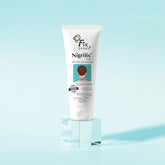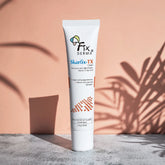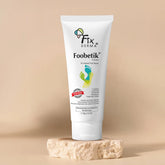Cracked Heels

Reasons Behind This
Dry Skin
The most common cause of cracked heels is dry and thickened skin. Due to the absence of oil glands on the soles of your feet, the skin loses moisture and becomes less flexible and prone to cracking.
Improper Footwear
Shoes that do not provide proper support or cushioning can increase pressure on the heels, leading to discomfort and cracky heels.
Aging
As we age, the skin naturally loses moisture and elasticity, making it more prone to dryness and cracking.
Dehydration
Staying dehydrated and keeping your skin parched for longer durations can cause skin to dry out, eventually leading to cracked heels.

How To Prevent Cracked Heels?
Moisturize Regularly
Apply a thick, hydrating moisturizer or foot cream, especially those containing urea, glycerin, or shea butter, daily to keep your heels soft and prevent dryness.
Exfoliate Gently
Use a pumice stone or foot scrub to gently remove dead skin from the heels. This prevents the buildup of thick, dry skin that can lead to cracking.
Stay Hydrated
Drinking enough water helps maintain the skin's hydration from the inside, preventing it from drying out and cracking.
Protect Your Skin From Cold Weather
In colder months, cover your feet with socks or shoes to protect them from dry, cold air that can exacerbate dry skin.

Risk Factors
Pain and Discomfort
Cracked heels can cause pain, especially when walking or standing, making daily activities difficult.
Severe Cracking
If not treated, minor cracks can deepen and worsen, leading to more significant damage and a longer healing process.
Inflammation
Cracks can become inflamed, leading to redness, swelling, and increased sensitivity in the affected area.
Social Discomfort
Visible cracked heels can lead to self-consciousness about foot appearance, impacting social interactions and confidence.

Tips From An Expert's Desk!
Use Humidifiers
If you live in a dry climate or during winter months, using a humidifier can help maintain moisture in the air, benefiting your skin.
Follow a Foot Care Routine
Develop a consistent foot care routine that includes cleaning, exfoliating, moisturizing, and inspecting your feet regularly for any signs of cracking or other issues.
Avoid DIY Remedies Without Caution
While home remedies can be helpful, be cautious with ingredients like vinegar or acids that might irritate sensitive skin. Always patch-test first.
Consult a Podiatrist
If you have persistent issues with cracked heels, consider consulting a podiatrist for personalized advice and treatment options.
Which cream is best for cracked heels?
In order to appear our best, we frequently spend a lot of money on facials as well as everyday care products like creams and serums. But despite how much we give our face attention, we often neglect our feet. And the outcome? Our heels get dry and cracked as a result and for this, we should find the best-cracked heel repair cream in India.
There is no limit to the suffering our feet endure, from fashionable yet uncomfortable shoes to being barefoot for extended periods of time. The skin of our heels also tends to grow dry, hard, and easily cracked since there aren't any oil glands there to keep them moisturized naturally. So, let's put the soul back into our soles and treat our feet to the greatest foot care possible. Shop for Fixderma Foobetik Cream, as it is the best cream for cracked heels. Foobetik cream is a specialized formulation that is enriched with skin-nurturing ingredients such as apple cider vinegar, tea tree oil, urea, lactic acid, and l-arginine that not only moisturizes feet’s skin but also repairs cracked heels and protects the feet from corns, calluses, and bacterial & fungal infection.
How do I get my heels to stop cracking?
Every day, check your feet. The importance of this increases if you have diabetes.
By regularly checking your feet, you can identify issues before they get worse. Search for:
- Dryness
- Swelling
- Corns
- Psoriasis
- Calluses
- Fungal infection
- Ingrown toenail
- Blisters
-
Make sure to wash them daily:
Wash your feet every day. Use warm water to wash your feet. Dry them well, making sure you get between your toes because the skin there tends to stay wet. Washing the feet removes bacteria and odour and exfoliates the accumulated dead skin cells. By removing those dead skin cells, you can reduce your risk of developing corns, calluses, and dry, hard, cracked, or flaky skin.
-
Apply Fixderma Foobetik Cream:
Fixderma foot cracks cream- Foobetik is formulated with urea and lactic acid, which exfoliates the skin cells. Lactic acid breaks the bonds between dead and hard skin cells to reveal softer skin. Additionally, it provides hydration to dry skin. Urea is a humectant and a well-known ingredient to treat cracked heels as it strengthens the stratum corneum barrier function to fight extremely hard and damaged skin.
FAQs
1. What causes cracked heels and how can Fixderma help?
Cracked heels are often caused by dry skin, prolonged standing, or poor footwear. Fixderma’s specialized creams and balms hydrate, soothe, and repair damaged skin, providing relief from cracked heels.
2. Which Fixderma product is best for treating cracked heels?
Fixderma’s Foot Repair Cream and Heel Balm are specially formulated to target dry, cracked heels. They deeply moisturize and promote skin regeneration for smooth, healthy feet.
3. How does Fixderma Foot Repair Cream work on cracked heels?
Our Foot Repair Cream contains natural ingredients like urea and shea butter that deeply hydrate and heal cracked heels, restoring softness and preventing further dryness.
4. Can I use Fixderma products to prevent cracked heels?
Yes, regular use of Fixderma’s foot care products, like our Heel Balm and Moisturizing Foot Cream, can prevent cracked heels by maintaining healthy skin hydration.
5. Is Fixderma Foot Care safe for sensitive skin?
Fixderma products are dermatologically tested and designed to be safe for sensitive skin, making them an excellent choice for anyone with dry or cracked heels.
6. How often should I apply Fixderma Foot Repair Cream?
For best results, apply Fixderma’s Foot Repair Cream twice daily—morning and night—on clean, dry feet, focusing on the heels for deep hydration and healing.
7. What are the benefits of using Fixderma Heel Balm on cracked heels?
Fixderma’s Heel Balm provides intense moisture, repairs cracked skin, and prevents future dryness. It also contains soothing ingredients that help reduce discomfort caused by cracked heels.
8. Can Fixderma’s foot care products be used on other dry skin areas?
Yes, Fixderma products like the Foot Repair Cream can be used on other dry and rough skin areas, including elbows and knees, to restore smoothness and hydration.
9. How long will it take to see results with Fixderma products for cracked heels?
With consistent use, visible results in the form of smoother, softer heels can be seen within 2-3 weeks of using Fixderma foot care products.
10. Can Fixderma help with deep cracks and fissures in heels?
Yes, Fixderma’s Heel Balm is specifically formulated to heal deep cracks and fissures, providing targeted treatment for severe heel damage and promoting skin regeneration.
11. Are Fixderma foot care products safe for diabetics?
Fixderma products are designed to be safe for most skin types, including diabetics.
12. How do I maintain soft heels with Fixderma?
Use Fixderma’s Foot Repair Cream daily to lock in moisture, and exfoliate your feet weekly to remove dead skin. Consistent care will maintain smooth and soft heels.
13. What are the ingredients in Fixderma products for cracked heels?
Fixderma foot care products contain nourishing ingredients like urea, glycerin, shea butter, and essential oils that hydrate, soothe, and repair cracked heels effectively.
17. How can I order Fixderma products for cracked heels?
Simply visit our
Cracked Heels Collection, select your desired products, and place your order online with free delivery on select items.
18. Are there any discounts available for Fixderma cracked heels products?
Stay tuned to our website for exclusive offers, promotions, and discounts on Fixderma’s foot care products for cracked heels. Sign up for our newsletter to never miss an update.



























